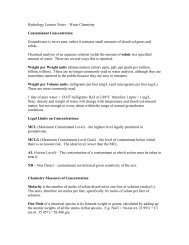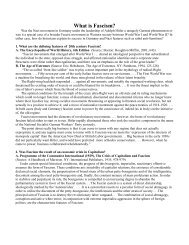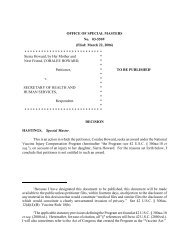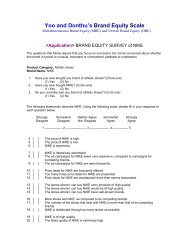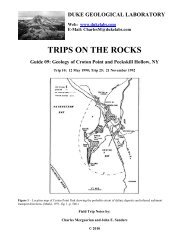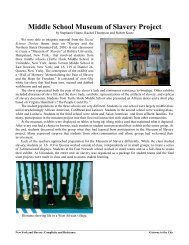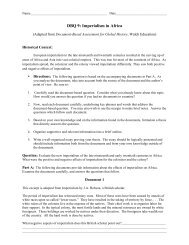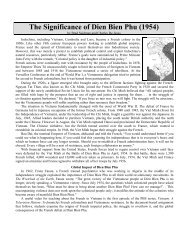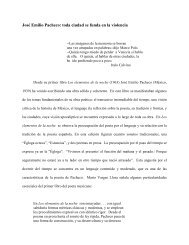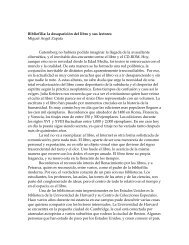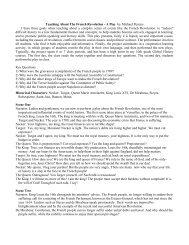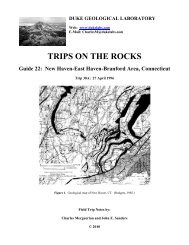AN ECOLOGICAL SURVEY OF A JAMAICAN MANGROVE SWAMP
AN ECOLOGICAL SURVEY OF A JAMAICAN MANGROVE SWAMP
AN ECOLOGICAL SURVEY OF A JAMAICAN MANGROVE SWAMP
You also want an ePaper? Increase the reach of your titles
YUMPU automatically turns print PDFs into web optimized ePapers that Google loves.
<strong>AN</strong> <strong>ECOLOGICAL</strong> <strong>SURVEY</strong><br />
<strong>OF</strong> A JAMAIC<strong>AN</strong> M<strong>AN</strong>GROVE<br />
<strong>SWAMP</strong><br />
Steven H. Vee<br />
Rock Valley College<br />
Rockford, Illinois
Introduction<br />
A study was done on various aspects of a small mangrove swamp as a research<br />
portion of a sabbatical leave in the fall of 1987. The work was done under the<br />
direction of Dr. Eugene Kaplan, with some help from the author's daughter,<br />
Annette Vee.<br />
The site was chosen because of its convenient location, walking distance<br />
from the Hofstra University Marine Lab Station. The site is visited by many<br />
student groups.<br />
While a field guide to the swamp has been written by Dr. Thomas<br />
Byrnes, more information about the area will increase its value to all who<br />
visit.<br />
The physical aspects of the swamp were recorded, including its location,<br />
climate of the area, salinity, water temperature, tidal fluctuations, prevailing<br />
winds, and hurricane history.<br />
A detailed mapping of the swamp was done. No previous maps of any detail<br />
were in existence. The map in this study was used in the Byrnes' field guide to<br />
the mangrove swamp. (Byrnes, 1987)<br />
Much of the field research involved an estimation of the structural<br />
parameters of the mangrove forest. Methods were used similar to those used by<br />
Pool, Snedaker, and Lugo, (1977) and Curtis and McIntosh, (1951). Species<br />
density per 0.1 ha, Basal area (m 2 /ha measured by diameter at breast height),<br />
tree density (number/ha), stand height (meters), and species importance value<br />
were determined for the swamp. By using methods similar to what other<br />
researchers have used to study other mangrove swamps in the Caribbean,<br />
comparisons can be made with a high degree of validity.<br />
Many collecting field trips were made to the mangrove swamp. While many<br />
other species were encountered, major attention was focused on animals of the<br />
Phyla Cnidaria, Mollusca, Arthropoda (Class Crustacea), and Echinodermata.<br />
Many
of the common members of these groups had previously been collected by Dr.<br />
Byrnes, but a number of different species were found. This is meant to aid<br />
future researchers in cataloging specimens, and also as an ongoing list which<br />
can be added to.<br />
It is hoped this paper will be used by instructors and students at the<br />
Hofstra University Marine Lab who wish to study in detail the Reader's Point<br />
Mangrove Swamp.
Literature Review<br />
The mangrove swamp is an ecosystem which, while not being ignored, has<br />
certainly not received the research attention it deserves. Despite the fact<br />
that mangrove swampSdominate a)! estimated 75% of all coastline between 25 ° North<br />
and 25 ° South latitude (Golley, Odum, and Wildon, 1962) and 25% of all Caribbean<br />
coastline (Jones and Sefton, 1978), good, comprehensive ecological surveys are<br />
notably lacking.<br />
The difficulties encountered in the swamp, as well as prevailing<br />
misconceptions may have accounted for the paucity of good research. The nearly<br />
impenetrable nature of the red mangrove prop root system, biting ants, knee-deep<br />
bottom ooze, anaerobic odors, pesky mosquitoes and the remote location from<br />
major research facilities have thwarted most scientists.<br />
Local myths have not promoted a positive attitude about mangrove swamps.<br />
This researcher has heard local residents say such things as "mangrove where de<br />
shark go durin de day" or "look out de alligator don't get ya".<br />
Mangroves exist to some extent on almost all West Indian Islands. They<br />
dominate protected shores such as the south coasts of Cuba, Puerto Rico and<br />
Jamaica, especially where rivers bring down silt or where lagoons exist.<br />
Patches of mangroves can be found in almost any area where protection from wave<br />
action will allow siltation to occur. (Jones and Sefton, 1978). While the<br />
mangrove swamp is technically limited to the forest area below the high tide<br />
mark (sometimes called a "tidal forest") the mangrove can extend farther inland<br />
(Lugo and Snedaker, 1974).<br />
Most mangrove swamps are dominated by the red mangrove, Rhizophora mangle.<br />
This species is the same world-wide, and is able to grow with its roots<br />
completely immersed in salt water. With its extensive prop root system<br />
supporting it, the tree promotes siltation by slowing wave action and water
currents. In this way, the red mangrove "walks out to sea", creating shallower<br />
water in a complex succession story. Whether or not this is a true succession<br />
story has been challenged by Egler, (1952), who found that in Florida mangroves<br />
the increase in peat formation in the swamps just kept up with the increase in<br />
sea level.<br />
Behind the Rhizophora mangle, moving landward, is a zone containing the<br />
black mangrove Avicennia germinans. Here it is not flooded with salt water<br />
except at high spring tides, but the soil is extremely saline and low in oxygen.<br />
(Lugo and Snekader, 1974). Special vertical pheumatophores on the root system<br />
extend above the ground in a very characteristic pattern and allow the roots to<br />
absorb oxygen from the air. As in the case with the Rhizophora, Avicennia can<br />
excrete salt from its tissues. Salt crystals are characteristically found on<br />
the surface of its leaves. (Bullard and Harrell, 1979)<br />
Above the reach of high tide, yet still in a muddy, water-logged soil,<br />
white mangroves, Laguncularia racemosa, can be found. Each species does its<br />
part in consolidating the swamp sediments to render the conditions more suitable<br />
for the next stage in the succession story. (Jones and Sefton, 1978).<br />
On dryer land behind the true black and white mangrove zones is found the<br />
gray mangrove or buttonwood, Conocarpus erectus, which is actually a terrestrial<br />
species of the scrub forest and not a true mangrove. (Jones and Sefton, 1978).<br />
In an actual mangrove swamp, such distinct red, black, white, and gray<br />
zones cannot be clearly delineated. Warner (1968) describes five zones of a<br />
Jamaican mangrove swamp beginning at the deep water of the lagoon.
First zone - "Fringe zone", 5% of the total swamp area,<br />
characterized by open growth of pure stands of<br />
Rhizophora.<br />
Second zone - "Rhizophora zone", 20-25% of the total swamp<br />
area, characterized by a tangled mesh of prop<br />
roots of pure stands of Rhizophora.<br />
Third zone - "Transition zone", 5-10% of the total swamp<br />
area. Rhizophora dominates this zone, but it<br />
is mixed with Avicennia and Laguncularia.<br />
Fourth zone - "Laguncularia and Avicennia zone", 40% of the<br />
swamp area.<br />
One half of the trees here are<br />
still Rhizophora but fully half of the trees<br />
are Laguncularia or Avicennia.<br />
Fifth zone - "Backzone", 15% of the swamp area. Dominated<br />
by Laguncularia and Avicennia.<br />
While it appears no two mangrove swamps are identical, Lugo and Snedaker,<br />
(1974) have defined five different basic types:<br />
Fringe mangrove forest - Found on edges of protected<br />
shorelines and islands, they are best defined along<br />
shorelines whose elevation are higher than the mean<br />
tide line.<br />
The coming and going of the tides is at a<br />
slow velocity and the swamp traps most of the debris.<br />
Riverine mangrove forest - This is an area that is flushed<br />
by daily tides, but is separated from drainage by a<br />
shallow berm.<br />
The flooding river will wash out excess<br />
salts and deliver nutrients to the swamp.
Overwash mangrove forest - This occurs on small, low islands<br />
or cays and fingerlike projections of land. The tidal<br />
flow overwashes it, as the name itself implies. Tidal<br />
velocities are high, and most organic debris is removed<br />
from the swamp.<br />
Basin mangrove forest - This occurs in inland areas where<br />
terrestrial runoff toward the coast is trapped by<br />
drainage depressions and tidal water enters from the<br />
sea.<br />
Dwarf mangrove forest - Also called a "scrub mangrove<br />
forest" by Pool, et. al. (1977) it is found on shallow,<br />
flat coastal fringes. Although all four major species<br />
of mangrove may be present, growth is stunted by high<br />
salinity, and/or lack of nutrients so that the height<br />
of the trees is less than 1.5 meters.<br />
Rhizophora mangle dominates the fringe, overwash, and dwarf mangrove<br />
forests. While it is also very prominent near the open water in riverine and<br />
basin mangrove forests, the red mangrove co-dominates with Avicennia in these<br />
swamps.<br />
The fact that there are fewer than ten species of New World plants which<br />
are halophytic (there are thirty-six in the Indo-West Pacific) which may be a<br />
clue that life in the mangrove swamps is not easy. Plants which grow in high<br />
saline environments transpire less than other plants. This is because the<br />
transpiration process requires a lot of energy to work against the osmotic<br />
gradient. If salinity increases, net productivity of the mangroves decreases.<br />
If salinity is decreased too much competition with other plants becomes more<br />
intense.<br />
(Lugo and Snedaker, 1974).
Each species of mangrove is, as one might surmise, best suited to the<br />
salinity of the zone in which it is predominantly found. Rhizophora<br />
productivity declines with increasing salinity, while Avicennia and Laguncularia<br />
productivity increase with increasing salinity. (Soto, et. al., 1982). The<br />
white mangrove is more halophytic than the black mangrove. This corresponds<br />
with the zones in which each predominates, as salinity increases shoreward away<br />
from the open water. (Carter, 1973).<br />
Canopy height can be used as a rough indicator of mangrove swamp<br />
productivity. Riverine and basin mangrove exhibit greater canopy height than<br />
dwarf, fringe, and overwash types. This ranking of productivity is consistent<br />
with rankings done by leaf-litter-fall production studies. (Pool, et. al.,<br />
1977)<br />
Productivity of a swamp is determined by a complex interplay of many<br />
different factors. The riverine and basin mangrove swamps receive enough<br />
flushing from fresh water to keep salinities low enough to permit high<br />
productivity. They are not flushed so much, however, that essential nutrients<br />
are washed away (as occurs in the overwash mangrove). The freshwater will also<br />
bring in nutrient-rich water from the land. (Pool, et. al., 1977)<br />
The dwarf or scrub mangrove and fringe mangroves are less productive due to<br />
high salinities from the lack of fresh-water flushing. The fringe mangrove,<br />
however, is not subject to excessive wave action to carry away its nutrients<br />
(Lugo and Snedaker, 1974), and ranks just below basin and riverine mangroves in<br />
productivity. (Pool, et. al., 1977)<br />
In the Caribbean, one generally expects a higher percentage of the<br />
coastline on the protected south shores of is:Lands to have mangroves, but the<br />
humid north coast mangrove swamps will be taller and more productive. (Pool et.<br />
al., 1977)
Holdrige (1971) reported maximum canopy height of Rhizophora at 30 meters<br />
+PUN F -<br />
with a maximum diameter of 90 cm. Bullard and Harrell (1975) list heights of 18<br />
meters for Avicennia and 10 meters for Laguncularia.<br />
The mangrove serves a very important ecological function as a bridge<br />
between the land and the sea. The swamp provides protection to the land during<br />
storms, but it also helps the productivity of the surrounding sea. The<br />
mangroves use the inorganic compounds of the land, and export organic compounds<br />
to the sea. (Lugo and Snedaker, 1974) Odum and Heald (1979) showed the<br />
connection between red mangrove detritus production and Florida sport fishing<br />
with a classic ecological study. In Florida's Fahkahatchee and Fahka Union<br />
Bays, Lugo and Snedaker (1974) estimated at least 57% and probably 80% of the<br />
total energy budget was supported by exports from mangrove forests. They also<br />
described the importance of crabs in breaking down mangrove leaves to eventually<br />
make the organic matter available to other levels of the food chain.<br />
An interesting study by John and Price (1979) noted a paucity of fleshy and<br />
filamentous algae on rocks and coral hummocks in Antigua. Taylor et. al. (1986)<br />
reported dominance of calcifying algae such as Halimeda on substrate-penetrating<br />
roots of Rhizophora.<br />
On "hanging" prop roots (those which did not touch the<br />
bottom sediments), however, they found domination by fleshy algae such as<br />
Acanthophora spic*fera, Caulerpa racemosa, and Spyrii"'dia filamentosa. Since<br />
fleshy algae do not have to expend energy making a calcareous skeleton, their<br />
productivity is higher, and they will dominate in a predator-free environment.<br />
In both studies, the presence of urchin predators, notably Echinometra lucunter,<br />
Diadema antillarum, Lytechinus variegatus, and Eucidaris tribuloides was causing<br />
the less-easily predated calcareous algae to be favored over the more productive<br />
fleshy algae. Only on hanging prop roots where these bottom-dwelling predators<br />
could not reach them were fleshy algae dominant.
To measure productivity of a mangrove swamp, many different approaches can<br />
be taken. Various exhaustive studies have involved collecting fallen leaves.<br />
Holdredge et. al. (1971) devised a "complexity index" as an "expression of the<br />
diversity and abundance within various types of forest communities." This index<br />
was made from the product of the number of species in a study area, the number<br />
of trees, the basal area, and the stand height. Using stand height alone as an<br />
indicator of productivity may have some validity as Cintron et. al. (1975)<br />
correlated decreasing stand height with increasing soil salinity. Odum (1970),<br />
however, showed that mangroves recovering from hurricane damage will have high<br />
productivity yet shorter canopy height.<br />
Measuring basal area (diameter of trunks at breast height; DBH) can also be<br />
done to determine productivity. Pool et. al. (1977) reported mangroves in<br />
general to be not as productive (in basal area) as other forest ecosystems with<br />
a low number of tree species, any or all of these methods can be used to compare<br />
one mangrove swamp's productivity to others previously studied.<br />
To report numerically the dominance of tree species in a forest, Curtis and<br />
McIntosh (1951) developed a Species Importance Value. This is determined by a<br />
summing of the relative percentages of basal area, density, and frequency for<br />
each species.<br />
Very few ecological surveys have been attempted which listed the species<br />
found in a mangrove swamp. The most useful survey for the Readers Point<br />
mangrove swamp is the HUML Field Guide by Dr. Thomas Byrnes (1987). Warner<br />
(1969) did a good job with Jamaican mangrove crabs of the Port Royal area.<br />
Barnwell (1986) reviewed the fiddler crabs of Jamaica, with emphasis on the<br />
history of their classification.<br />
Other studies have been done dealing with the<br />
ecology of mangroves in other Caribbean islands, but they are less helpful.<br />
Mangrove swamps around the world are threatened by a variety of forces.
Hurricanes are a natural way the swamps are destroyed. By absorbing the force<br />
of such storms, mangroves help to protect shorelines from hurricane damage.<br />
Some swamps are protected by their secluded location, but others will be<br />
devasted by hurricanes. (Lugo and Snedaker, 1974)<br />
Man, as is so often the case with other ecosystems, is the major threat to<br />
mangrove swamps. The need for such products as tannin, construction timber and<br />
charcoal, which can be obtained from mangroves, sometimes depletes the swamp<br />
faster than it can grow. Far greater damage, however, is done by herbicides,<br />
stream channelization and drainage.<br />
Man's pressing desire for more land for<br />
tourist developments, harbors, and agricultural land is rapidly depleting this<br />
valuable resource. (Lugo and Snekader, 1974)
Methods and Materials<br />
Complexity indexing which involves the major portion of the research data,<br />
is a method which has been used to express diversity and abundance within<br />
various forest ecosystems. Complexity indexes were obtained for a variety of<br />
mangrove forests by Pool, Snedaker and Lugo (1977). Calculating this data for<br />
the Reader's Point Mangrove Swamp allows a comparison with forests in other<br />
parts of the Caribbean.<br />
The complexity index was calculated both for trees over 10 cm in diameter<br />
at breast height (DBH) and for trees under 10 cm DBH but over 2.5 cm DBH. The<br />
index is the product of the number of species in the study plot (s), the stand<br />
density (number of individual trees) (d), basal area in square meters (b),<br />
height of the stand in meters (h), and 10 -3 .<br />
Two plots were selected at random for analysis. Each plot was 12.5 meters<br />
x 40 meters for a combined area of 1000 sq. meters or 0.1 hectare. Sites were<br />
roped off and all stems measured and recorded. Chalk was used to mark the trees<br />
to avoid counting any tree twice. In Rhizophora that were-developed, the<br />
diameter was not measured at breast height, but rather at the point just above<br />
the entry of the last prop root (in some cases this was 3-4 meters above water<br />
level.)<br />
Stand height was determined by formation of an isosceles triangle. No<br />
inclinometer or Haga altimeter was available due to the remote location, so a<br />
device was constructed to measure 45 0 angles. Distance from the tree trunk<br />
where the tree top measured 45 0 from the plane of the ground was estimated to be<br />
the stand height.<br />
Species Importance Value was developed by Curtis and McIntosh (1951) to<br />
show quantitatively the importance of various species in relation to each other<br />
in a mixed stand of trees. It is calculated by averaging the relative<br />
percentages of basal area, density, and frequency contributed by each species.
Mapping of the swamp was accomplished by :measuring (with string) as many<br />
dimensions as possible and noting compass points with each measurement.<br />
Comparisons were made with available local maps, but no maps of the area showed<br />
the mangroves very precisely.<br />
Collecting was done mostly by hand. Hand nets were used to probe the<br />
bottom surface, and to sift through bottom sediments for crabs and mollusks.<br />
Salinity was determined by use of a hydrometer and thermometer.<br />
Measurement of the specific gravity of the water was then translated to salinity<br />
by use of a standard conversion chart.
Site Description<br />
The mangrove swamp studied shall be called the Reader's Point Mangrove<br />
Swamp since no other name appears to exist. It is located on the north shore of<br />
Jamaica about 1.5 miles southeast of the Hofstra University Marine Lab Station.<br />
Its location at the southeast end of Prioy Bay gives it protection, by Lee Reef,<br />
from high seas. It is also protected from the north-easterly trade winds by its<br />
location behind Reader's Point.<br />
North.<br />
Jamaican climate is classified as tropical with a local latitude of 18 ° 26'<br />
The temperature of the sea varies from 81 ° --F to 84 ° --F with the high<br />
extreme being the case during the study period of September.<br />
October and May are the wettest months of the year, while February and<br />
March are the driest. The rainfall in Jamaica is highly variable across the<br />
island. Charts show the St. Ann's Bay area, including the lab, to receive about<br />
1500-2000 mm (60-80 inches) of rain per year. The local people seem skeptical<br />
of that figure, citing recent changes in weather patterns bringing less rain.<br />
Even at 2000 mm per year, for a north coast location, that is fairly dry.<br />
While two small drainage ditches lead into the mangrove swamp, an influx of<br />
fresh water occurs only after a heavy rain. During dry periods, there is no<br />
flow into the swamp, and salinity levels are quite high. During September,<br />
which is normally a wet month, salinity levels of 43 ppt were recorded after a<br />
full week with no rain.<br />
Tides all around Jamaica are very small. In Prioy Bay there are two high<br />
tides and two low tides per day with the extremes from maximum spring high to<br />
minimum spring low at 51 cm. Normal fluctuation is 20-30 mm. In the mangroves<br />
the velocity of the tides is so slow that no flushing of detritus into the bay<br />
occurs. After severe storms, a sulfur smell from the mangroves can be detected<br />
at the marine lab, however.
The Reader's Point Mangrove Swamp should be classified as a fringe type.<br />
It extends about 500 meters along the coast, and varies from about 5 meters to<br />
50 meters in width. Determining the width depends upon how far inland one<br />
defines swamp to extend. The tides are so small, and the bank elevation<br />
increases so fast, that the horizontal distance on the shore from low-low tide<br />
to high-high tide in most areas is five meters or less. Some white mangrove and<br />
gray mangrove trees can be found at considerable distances form the high tide<br />
mark, farther inland than Coccoloba and Acacia trees, in fact.<br />
Defining the edge of the swamp to be just above the high tide mark, where<br />
scrub forest species begin to appear, the Reader's Point Mangrove Swamp has an<br />
area of about 1.2 hectares. It is bounded on one side by a refuse dump, and by<br />
Reader's Point on the other. Its small size, while perhaps limiting the<br />
diversity of species, makes it a manageable study area.<br />
Allen.<br />
In 1980, the north coast of Jamaica was severely damaged by Hurricane<br />
Perhaps because of its protected location behind Reader's Point, no<br />
obvious evidence of hurricane destruction was found. No large tree stumps or<br />
fallen trees were present, although it is possible that in seven years, the<br />
swamp could have recycled such vegetation. Judging from the size of many of the<br />
Red Mangrove trees, however, it appeared most of the trees were pre-hurricane.
Structural Parameters<br />
Results and Conclusions<br />
The complexity index was calculated for both trees over 10 cm in diameter<br />
at breast height (DBH) and for trees under 10 cm but over 2.5 cm DBH, because<br />
Pool et. al. (1977) used this method. In this way, the Reader's Point Mangrove<br />
Swamp can be compared with swamps in Florida, Puerto Rico, Mexico, and Costa<br />
Rica for which similar data ha'ebeen published. The author feels a combined<br />
complexity index, which would include all trees over 2.5 cm DBH would be much<br />
more meaningful, but results are reported so they can be compared with<br />
previously studied areas.<br />
In the two study plots (whose combined area was 0.1 hectare) there were<br />
three species of mangrove trees found, Rhizophora mangle (red), Laguncularia<br />
racemosa (white), and Avicennia germinans (black). The fourth type, Conocarpus<br />
erectus (grey or button) is prevalent in the driest zones of the swamp, but did<br />
not happen to occur in the selected study plots. There were 101 red mangroves<br />
measured over 10 cm DBH, and 38 between 2.5cm and 10 cm DBH. There were 8 white<br />
mangroves measured over 10 cm DBH, and 3 between 2.5 cm and 10 cm DBH. Only one<br />
black mangrove over 10 cm DBH and one over 2.5 cm but under 10 cm DBH were found<br />
in the plots.<br />
The basal area for all. trees over 10 cm DBH was 2.524 m 2 per 0.1 hectare,<br />
or 25.24 m 2 per hectare (See table A). For trees over 2.5 cm but under 10 DBH,<br />
the basal area was 0.158 m2 per 0.1 hectare or 1.58m 2 per hectare (See table B).<br />
One meaningful measure of the productivity of a forest, which Pool et. al.<br />
(1977) failed to report, is the total basal area. For the Reader's Point<br />
Mangrove Swamp there is a total basal area of 26.82m 2 /ha.<br />
Stand height was measured at 14 meters. Many trees in both plots exceeded<br />
12 meters in height. This was slightly higher than reported values for other<br />
fringe mangrove swamps. (See Reprint 112, "figure 11")
The complexity index for trees greater than 2.5 cm DBH but under 10 cm DBH<br />
was 2.8. For those trees greater than 10 cm DBH the complexity index was 11.6<br />
(See table D). These numbers can be compared with values obtained by Pool et.<br />
al. (1977) (See reprint #1, "Table 2"). The same researchers reported a mean<br />
complexity index of 4.8 (for DBH>10 cm) for all mangrove forests in tropical dry<br />
life zones. For tropical moist life zones, an index of 72.0 was reported<br />
(Reprint #2 "Table 5").<br />
The author was not as certain of the validity of complexity indexing at the<br />
end of the study as anticipated. The index varies dramatically from study area<br />
to study area. In the Reader's Point Mangrove Swamp three species were found,<br />
but only one black mangrove was counted. Had that one tree not been in the<br />
study area, the complexity index would be 33% lower than reported. In a scrub<br />
mangrove swamp, where no trees over 2.5 cm can be found, the complexity index<br />
for trees over 10 cm DBH must be zero. A formula to replace the present method<br />
should be devised.<br />
The complexity index for the Reader's Point Mangrove Swamp fell within the<br />
wide range of figures reported in "Table 2". The basal area which may give a<br />
better indication of the productivity of the swamp, was very similar to other<br />
fringe mangroves. The figures reported for basin-type mangrove swamps varied<br />
widely, but riverine-type swamps were much higher in basal area.<br />
Riverine mangrove swamps have two major advantages over the fringe type<br />
found at Reader's Point. Salt concentrations, which will decrease the<br />
productivity, are not allowed to build through evaporation, as there is a<br />
constant addition of fresh water. Mineral nutrients from the land are also<br />
continually being added to the riverine swamp at a faster rate than occurs in<br />
the fringe-type swamp.
The Reader's Point Mangrove Swamp is not in a truly moist tropical zone,<br />
yet its rainfall is near the high end of the dry tropical zone designation (See<br />
Reprint #2, "figure 12"). The data reported for complexity index and basal area<br />
fall within expected values.<br />
Another interesting aspect of the data collected is the calculating of<br />
importance value. The summing of basal area, density and frequency for each<br />
tree species of the Reader's Point Mangrove Swamp shows a strong dominance of<br />
Rhizophora mangle (91.9%), :followed by Laguncularia racemosa (7.0%), and<br />
Avicennia germinans (1.1%) (See table C). The dominance of red mangrove is<br />
typical of a fringe mangrove swamp because of the small intertidal zone where<br />
the other mangrove species can co-exist. The short distance from a niche which<br />
is nearly constantly immersed to that which never receives tidal wash also<br />
explains why white mangroves, which are better suited to dry land than black<br />
mangroves, are dominant over blacks.<br />
Species Encountered<br />
A mangrove swamp offers a wide variety of physical conditions within its<br />
broad boundaries. These varied microenvironments make many niches available for<br />
numerous, vastly different species to occupy. In a fringe-type mangrove swamp<br />
such as found at Reader's Point, this is strikingly apparent because of the<br />
compaction of the zones. In a distance of as little as 5-10 meters, the<br />
environment changes from terrestrial to intertidal, to sub-tidal.<br />
In the Phylum Cnidaria, two Scyphozoans were found in the open water near<br />
Rhizophora. Carybdea alata (sea wasp) was seen rarely during the day, in small<br />
schools near open, silty bottoms. Cassiopeia xamachana (upside-down jellyfish)<br />
was consistently found on the bottom in 2-4 feet of water.
Although no corals were present, a small number of species of class<br />
Anthozoa had large populations. The anemone Anthopleura krebsi (rock anemone)<br />
was the most numerous, coating many of the Rhizophora prop roots. Searches for<br />
Aiptasia tagetes revealed none on prop roots. On the muddy bottom near prop<br />
roots numerous Phyllactis flosculifera (collared sand anemone) were found,<br />
especially in shallow water.. In the open water, under clumps of Halimeda were<br />
many Bartholomea annulata (ringed anemone) with only their characteristic<br />
tentacles exposed.<br />
Heteractis luc 4a was not found, which leaves only supposition to explain<br />
the stinging experienced by scientists. B. annulata was not capable of stinging<br />
this investigator, but something on the blades of Halimeda and Thalassia was. A<br />
possible answer may be nematocysts drifting in from elsewhere, or possibly<br />
unseen hydrozoans on the vegetation. H. luc +a may also be present, but not<br />
i~ , ~~~w s aa,~,v~~-+vt tl=<br />
" . 5 rN~irNq au '=irvLE A~ , ec, gv~~~at~~,~s,<br />
collected. Y<br />
C,rrCi~IiQN$IS,~ S - fi~'r- 4 ,'4rArs~ 52 .t,~i fvc CAI VI -i # ~( t1 C-f obsc*Yrr'S.<br />
The mollusks found in the mangroves were mainly Gastropods, but some<br />
bivalves were encountered. Isognomon alata (flat tree oyster) can be easily<br />
located on Rhizophora prop roots, stacked like pancakes just above or just below<br />
the water level near the low tide level. Arcopagia fausta (faust's tellin), a<br />
dead shell commonly found around octopus dens in other parts of the bay, was<br />
found alive in the mud of the open water. The only other bivalve found was the<br />
diminutive Tellina exilis (pink-thin tellin), from the mud near Rhizophora prop<br />
roots.<br />
Of the Gastropods, many were extremely abundant and easily found.<br />
Littorina angulifera (angulate periwinkle) common on Rhizophora prop roots, just<br />
above water level. Neritina virginea (virgin nerite), Cerithium littoratum,<br />
Batillaria minima (false cerith), and Cerithium variabile (dwarf cerith) which<br />
looks much like Batillaria minima, was found by the hundreds on blades of<br />
Halodule grass in very shallow water. The virgin nerite is interesting to look<br />
at under a dissecting microscope because of the ornate patterns and the fact<br />
+hn+ r,n +w,,n ehnllc coom to lnnk alike.
Also common were the pulmonate snails on the leaf litter above the tide<br />
level. Melampus coffeus (coffee melampus) and Melampus monile (yellowish<br />
melampus)were in mixed groups, and nearly indistinguishable.<br />
Encountered less often were the voracious Fasciolaria tulipa (true tulip)<br />
and cerithium algicola (middle-spined cerith). The dead shells of the former<br />
were many times seen occupied by the striped hermit crab, Clibanarius vittatus.<br />
The same crab was found in shells of Tonna maculosa (Partridge tun), although<br />
live specimens of this allusive snail were not collected.<br />
The spotted sea hare, Aplysis dactylomela, was either quite numerous, or<br />
not present at all. Migration in and out of the mangrove swamp may be linked to<br />
moon cycles for this beautiful gastropod.<br />
Other dead shells collected were Thais haemastoma floridana, Murex<br />
antillarum, Codakia orbicularis, and Asaphis deflorata. Whether these were<br />
present live or were washed in is not known. Three specimens of a small<br />
polished white snail, probably of the Pyramidellidae family were found near and<br />
inside the anus of a Holothuria mexicana sea cucumber.<br />
The Phylum Arthropoda was well represented by the numerous ants,<br />
butterflies, termites and spiders, but no effort was made to collect these.<br />
Collection was confined to the class Crustacea, with concentration on the<br />
Brachyuran crabs.<br />
Since many crustaceans are either detritus feeders or scavengers, they are<br />
very numerous in the mangrove swamp with its abundant leaf-litter. De La Cruz<br />
and Banaag (1967) reported crabs to be the dominant faunal inhabitants of<br />
Philippine mangroves.<br />
Probably the most numerous crab was the mangrove tree crab, Aratus pisonii,<br />
found mostly on the seaward edge of the swamp. This beautifully colored crab<br />
has the interesting behavior of hiding on the side of Rhizophora prop roots
opposite the observer. Seemingly scarce at first, this crab appears everywhere<br />
once one knows where to look. This researcher found as many as five on one prop<br />
root!<br />
Another group of crabs found near the seaward side of the mangrove swamp<br />
was the Callinectes crabs. Although difficult to tell apart, Callinectes<br />
sapidus, Callinectes exasperatus, and CQllinectes danae were probably all<br />
present.<br />
Microphyrys bicornutus (decorator crab) was also common in the subtidal<br />
areas. This crab was occasionally collected from the inside of clothing, as it<br />
seems to like crawling up pant legs. A small crab found in muddy bottom areas<br />
throughout the swamp was difficult to classify. It was a Xanthid crab,<br />
probably Actae sp.<br />
Some of the most interesting crabs found were the fiddler crabs, named for<br />
the males "fiddle and bow" claws. Barnwell (1986) reported historic collections<br />
of eight species of Uca in Jamaican waters. Uca thayeri, Uca rapax, Uca<br />
leptodactyla, Uca major, Uca burgersi (formerly called Uca mordax (Holthuis,<br />
1967), Uca cumulanta, Uca spinicarpa, and Uca heterochelos have all been<br />
reported, but the last two are extremely rare. In one small area near Reader's<br />
Point, five species (U. thayeri, U. rapax, U. leptodactyla, U. major, and U.<br />
burgersi) were easily collected. The smallest, U. leptodactyla, was the most<br />
numerous. (Vee, 1987)<br />
The hermit crabs found most often were Clibanarius tricolor (red, white and<br />
blue hermit crab) on shore, and Clibanarious vittatus (striped hermit crab) in<br />
the water. Immature Coenobita clypeatus were also found as hermit crabs, while<br />
the adults were encountered farther from the high tide mark.<br />
In the leaf litter above the high-tide mark, Sesarma curacoensis and<br />
Sesarma ricordi were found, but they were not as numerous as Pachygrapsus
gracilis. Goniopsis cruentata (mangrove crab) with the beautiful red legs was<br />
surprisingly plentiful, especially among the roots of mangroves stumps where<br />
trees had been cleared.<br />
Many Cardisoma guanhum:i (Great Land Crab) could be seen any night, but<br />
unlike the fiddler crabs, they are most active during high tide. Far less<br />
numerous, but occupying similar large holes, Ucides cordatus was also found. In<br />
drier areas, Gecarcinus ruricola was collected.<br />
Mantis shrimp, Gonodactylus oerstedi, were common, and probably occupy a<br />
majority of the holes seen on the open bottom areas.<br />
Synalpheus brevicarpus<br />
shrimps could be heard in most shallow areas at night. Living among the dense<br />
epiphytes and epizoites of the Rhizophora prop roots, an, occasional pair of<br />
banded shrimp, Stenopus hispip dus could be seen. Only immature Panulirus argus<br />
were found. Lysmata wurdemanni shrimps were also found in collections made with<br />
a fine-mesh net.<br />
Phylum Echinodermata was not well represented in the species collected.<br />
Only four species were found, but all were quite common.<br />
Synaptula hydriformis,<br />
called "green snot sea cucumber" by Byrnes (1987) was the most numerous species,<br />
being found in heavy densities on the Rhizophora prop roots.<br />
Also extremely<br />
common was the Donkey Dung Sea Cucumber, Holothuria mexicana, which occupies<br />
open areas of the swamp. Mixed in with Holothuria mexi(ana was the five-toothed<br />
sea cucumber, Actinopygja agassizii, many times housing a resident pearl fish in<br />
the digestive tract. In small groups scattered at the base of Rhizophora prop<br />
roots were smaller, yellow-footed sea cucumbers, Holothuria rg isea.<br />
All Echinoderms found were in the class Holothuroidea, no representative of<br />
the other four classes was encountered. The paucity of other Echinoderms,<br />
especially of the class Echinodea was a surprise. The abundance of algae and<br />
grasses on which to feed should support a good population of the common sea eggs
or other urchins. These species are not commonly used for food in the area.<br />
Except for an occasional fisherman, few natives venture into the mangrove swamp,<br />
so overcollecting of any species is not a problem. The lack of urchins probably<br />
accounted for the variety of fleshy and calcaerous algae observed on Rhizophora<br />
prop roots. No domination by predator-resistent calcereous algae was observed.
Summary<br />
The small mangrove swamp at Reader's Point turned out to be a very<br />
interesting area for ecological study. It is a fringe-type mangrove swamp of<br />
about 1.2 hectare size, with typical heavy domination by Rhizophora mangle<br />
trees.<br />
All four species of mangrove were well-represented in their classic<br />
zones, and a healthy scrub forest ecosystem exists behind the swamp.<br />
The productivity of the swamp as measured by basal area of the trees, stand<br />
height, and complexity is within an expected range for similar fringe-mangrove<br />
swamps.<br />
Lack of higher productivity is probably due to lack of nutrients from<br />
the location away from streams, and seasonal high salinity from lack of regular<br />
fresh-water flushing.<br />
A good variety of species was encountered, a sign of good ecological health<br />
of the swamp. The surprising number of different crab species and populations<br />
of each was of special interest. The lack of non-Holothuroidean Echinoderms<br />
remains a mystery.<br />
It is hoped this study can be followed up by periodic checks on the growth<br />
in area of the swamp, and increases in basal area and stand height. The lists<br />
of species encountered can also be used by future student groups or researchers<br />
as a starting point for further collections.
Phylum: Cnidaria<br />
Class: Scyphozoa<br />
Carybdea alata<br />
Cassiopea xamachana<br />
Class: Anthozoa<br />
Phylum: Mollusca<br />
Phyllactis flosculifera<br />
Anthopleura krebsi<br />
Bartholomea annulata<br />
Class: Bivalva<br />
Arcopagia fausta<br />
Tellina exilis<br />
Isognomon alata<br />
Codakia orbicularis (dead)<br />
Asaphis deflorata (dead)<br />
Class: Gastropoda<br />
Fasciolaria tulina<br />
Cerithium algicola<br />
Cerithium variabile<br />
Batillaria minima<br />
Neritina virginea<br />
Littorina angulifera<br />
Tonna maculosa (dead)<br />
Aplysis dactylomela<br />
Melampus coffeus<br />
Melampus monile<br />
Species Encountered<br />
Thais haemastoma floridana (dead)<br />
Cerithium littoratum<br />
Murex antillarum (dead)<br />
Pyramidellidian snail (probably Mellanella sp.)
Phylum: Arthropoda<br />
Class: Crustacea<br />
Clibanarius tricolor<br />
Clibanarius vittatus<br />
Aratus pisonii<br />
Goniopsis cruentata<br />
Cardisoma ug anhum<br />
Ucides cordatus<br />
Callinectes sapidus<br />
Callinectes exasperatus<br />
Callinectes danae<br />
Microphyrus bicornutus<br />
Sesarma curacoensis<br />
Sesarma ricordi<br />
Pachygrapsus gracilis<br />
Coenobita clypeatus<br />
Actae sc.<br />
Gecarcinus ruricola<br />
Gonodactylus oerstedi<br />
Synalpheus brevicarpus<br />
Stenopus hispidus<br />
Panulirus argus<br />
Lysmata wurdemann:<br />
Uca thayeri<br />
Uca burgersi<br />
Uca rapax<br />
Uca leptodactyla<br />
Uca major<br />
Phylum: Echinodermata<br />
Class: Holothuroidea<br />
Holothuris grisea<br />
Synaptula hydriformis<br />
Actinopygia agassizii<br />
Holothuria mexicana
Table A<br />
Diameter and Basal Area of All Trees over 10cm<br />
[combined Data, Plots 1 and 2 (total = 0.1 hectare)]<br />
Rhizopora> 10 cm (101 trees)<br />
Diameter Area (TT R ) Diameter Area Diameter Area<br />
19cm 283cm 23 415 22 380<br />
18 254 13 133 11 95<br />
14 154 23 415 11 95<br />
11 95 14 154 17 227<br />
13 133 26 531 14 154<br />
15 177 11 95 14 154<br />
13 133 15 177 11 95<br />
22 380 20 314 11 95<br />
20 314 15 177 10 79<br />
14 154 10 79<br />
14 154 11 95 Total area 23,298cm 2<br />
14 154 11 95<br />
10 79 17 227 Laguncularia> 10cm (8 trees)<br />
12 113 26 531 Diameter Area 2<br />
26 531 11 95<br />
24cm 452cm<br />
12 113 27 572 17 227<br />
16 201 23 415 15 177<br />
13 133 15 177 12 113<br />
26 531 22 380 14 154<br />
22 380 14 154 14 154<br />
13 133 12 113 15 177<br />
16 201 15 177 15 177<br />
17 227 10 79<br />
12 113 10 79 Total area 1,631cm 2<br />
15 177 11 95<br />
18 254 18 254 Avicennia > 10cm (1 tree)<br />
21 346 17 227 Diameter Area 2<br />
13 133 10 79<br />
20cm 314cm<br />
10 79 10 79<br />
18 254 14 154<br />
13 133 21 346 Total Basal Area<br />
11 95 11 95 Rhizophora 23,298cm 2<br />
19 283 15 177 Laguncularia 1,631<br />
13 133 19 283 Avicennia 314<br />
25 491 15 177<br />
16 201 27 572 25,243cm 2<br />
27 572 17 227<br />
31 754 28 615 = 2.524 m 2 /0.lha<br />
16 201 11 95 = 25.24 m 2 /ha<br />
10 79 28 615<br />
16 201 20 314<br />
23 415 19 283<br />
12 113 23 415<br />
11 95 15 177<br />
16 201 11 95<br />
14 154 18 254<br />
12<br />
113
Table B<br />
Diameter and Basal Area of All Trees between 2.5 cm and 10 cm<br />
[combined data plots 1 and 2, (total = 0.1 hectare)]<br />
Rhizophora >2.5cm < 10 2cm. (38 trees) Laguncularia >2.5cm < 10 cm. (3 trees)<br />
Diameter Area (TTR ) Diameter Area<br />
5cm 20cm 2<br />
7 cm<br />
2<br />
38cm<br />
6 28 9 64<br />
7 38 7 38<br />
6 28<br />
9 64<br />
2<br />
Total Area = 140cm<br />
5 20<br />
5 20<br />
7 38<br />
5 20<br />
9 64 Avicennia >2.5cm < 10 cm. (1 tree)<br />
6 28 Diameter Area2 7 38 7cm 38cm<br />
7 38<br />
9 64<br />
7 38<br />
6 28<br />
7 38<br />
9 64<br />
8 50 Total Basal Area<br />
9 64 Rhizophora 1402cm 2<br />
6 28 Laguncularia 140<br />
8 50 Avicennia 38<br />
4 13<br />
5 20 1580cm 2<br />
8 50<br />
6 28 = . 158 m2 /0.lha<br />
8 50 = 1.58 m2 /ha<br />
4 13<br />
4 13 Combined Basal Area<br />
5 20 Table A 2.524 m2/0.1 ha<br />
6 28 Table B . 158 m /0.1 ha<br />
7 38<br />
8 50<br />
5 20 Grand total for all trees 2.682 m2/0.1 ha<br />
4 13 or 26.82 m /ha<br />
9 64<br />
9 64<br />
8 50<br />
Total Area = 1402 cm 2
Table D<br />
Table C<br />
Importance Values<br />
Tree Species Basal Area Density Frequency Importance Value<br />
Rhizophora mangle 92.3% 91.8% 91.5% 91.9%<br />
Laguncularia racemosa 6.5% 7.3% 7.2% 7.0%<br />
Avicennia germinans 1.2% 0.9% 1.3% 1.1%<br />
Complexity Index<br />
Number of Number of Trees Basal area m 2 /O.lha Stand Complexity<br />
Species >2.5cm10cm >2.5cm10cm height (m) Index<br />
>2.5cm10cm<br />
3 4.2 110 . 158 2.52 14 . 28 11.6
TABLE 2. Structural comparisons of mangrove forests of southern Florida, Puerto Rico, Mexico, and Costa Rica. Complexity components are expressed on a 0.1<br />
ha basis.<br />
Number<br />
SITE classification) c s e species<br />
>2.5 mDBH> 10DBH<br />
(m 2 )<br />
>2.5 mDBH> $ c )<br />
Stand<br />
height<br />
( m)<br />
Complexity i c h<br />
>2.5 cm DBH >10 m DBH'<br />
Florida, U.S.A.<br />
Ten Thousand Islands<br />
Plots 3-7, 3-8 (overwash) 2 180 60 1.50 1.10 6.3 3.4 0.8<br />
Plots 5-11, 5-12, 5-13 (fringe) 2 280 80 2.35 1.24 7.3 9.6 1.4<br />
Plots 6-14, 6-15 (riverine) 2 400 60 3.85 2.17 9.0 27.7 2.3<br />
Rookery Bay (basin) 3 590 66 2.03 1.44 6.5 23.4 1.9<br />
Turkey Point (scrub) 1 2503 0 0.60 0.00 1.0 1.5 0.0<br />
Puerto Rico<br />
Pifiones I (basin) 3 197 57 1.58 0.37 14.0 13.1 0.9<br />
Pifiones II (basin) 3 321 46 1.69 0.56 11.5 18.7 0.9<br />
Pifiones III (basin) 3 138 68 1.69 1.55 16.0 11.2 5.1<br />
Pifiones IV (basin) 3 285 81 2.16 0.96 13.0 24.0 3.0<br />
Vacia Talega (riverine) 3 189 98 2.09 1.71 13.0 15.4 6.5<br />
Ceiba (fringe) 2 569 26 1.67 0.34 8.5 16.2 0.2<br />
Morn Island (basin)% 2 293 179 3.50 2.97 15.0 30.8 15.9<br />
Aguirre (fringe) 3 367 111 2.26 1.39 12.0 29.9 5.6<br />
Jobos Bayb<br />
Plots 1-6 (overwash) 3(1)e 1165 26 1.55 0.32 4.8 26.0 0.0d<br />
Plots 7-11 (fringe) 2 2059 0 1.44 0.00 4.4 26.1 0.0<br />
Plots 12-35 (fringe) 3(2)e 4733 17 1.43 0.17 4.8 97.5 0.0d<br />
Ptsnta Gorda (fringe) 1 178 26 0.69 0.31 7.0 0.9 0.0d<br />
Mexico<br />
Roblitos (riverine) 2 224 91 2.96 2.41 8.0 10.6 3.5<br />
'-- (riv<br />
1°Ia * i- s s -<br />
Pall - 11a weririe) 3 23u 145 6.08 5.59 17.0 73.2 41.3<br />
Isla Roscell (overwash) 3 148 91 2.85 2.62 8.0 10.1 5.7<br />
El Cal6n (basin) 2 312 61 1.52 0.83 9.0 8.5 09<br />
Rio de las Canas (riverine) 3 179 103 5.78 5.61 16.0 49.7 27.7<br />
Costa Rica<br />
Moin (riverine)e 4 137 118 9.64 9.53 16.0 84.5 72.0<br />
Boca Barranca (riverine)t 3 110 66 3.29 3.18 9.5 10.3 6.0<br />
Santa Rosa (fringe) 2 105 80 2.32 2.22 10.0 4.9 3.6<br />
'Data from Rogers and Cintr6n 1974.<br />
b Data from the Natural History Society of Puerto Rico 1972.<br />
'Only one and two species respectively were recorded in stem diameter class greater than 10 cm.<br />
d Complexity indices calculated were less than 0.1.<br />
Measured red, black and white mangroves and Pterocarpus officinalis.<br />
r Measured red and black mangroves and Pelliciere rhizophorae.
Bibliography<br />
Barnwell, F.H., 1986. Fiddler Crabs of Jamaica (Deca poda, Brachyura,<br />
Ocypodidae, Genus Uca). Crustaceana. 50(2).<br />
Bullard, L., Harrell, J., 1979. Coastal Plants of Florida. Florida Department<br />
of Agriculture and Consumer Services, Division of Forestry.<br />
Byrnes, T., 1987. A Field Guide to the Mangrove Swamps Near the Hofstra<br />
University Marine Laboratory and Reader's Point. Hofstra University Marine<br />
Laboratory. Publication #16.<br />
Carter, M.R. et al. 1973. Ecosystems Analysis of the Big Cypress Swamp and<br />
Estuaries. ESEPA printing.<br />
Cintron, G., Lugo, A., Pool, D., and Morris, G. 1975. Los Manglares de las<br />
Costas Aridas de Puerto Rico. II Latin American Symposium on Biological<br />
Oceanography. Cumana, Venezuela.<br />
Curtis, J. T., and McIntosh, R. P. 1951. An Upland Forest Continuum in the<br />
Prairie-forest Border Region of Wisconsin. Ecology, 32:476-496.<br />
De La Crus, A., and Banaag, J. 1967. The Ecology of a Small Mangrove Patch in<br />
Matabung Kay Beach, Batangas Province. Natur. Appl. Sci. Bull. 20:486-494.<br />
Egler, F. E. 1952. Southeast saline Everglades Vegetation, Florida, and its<br />
management. Veg. Acta Geobot. 3:213-65.<br />
Golly, F., Odum, H. T., and Wilson, R. F. 1962. The Structure and Metabolism<br />
of a Puerto Rican Red Mangrove Forest in May. Ecology, 43, 9-19.<br />
Holdrige, L. R., et al. 1971. Forest Environments in Tropical Life Zones.<br />
Pergamon Press. N.Y.<br />
Holthuis, L., 1967. On a New Species of Uca fromthe West Indian Region<br />
(Crustacea, Brachyura, Ocypodidae). Zoologische Mededelingen. Deel 42<br />
No. 6.<br />
John, D. M., and Price, J. H. 1979. The Marine Benthos of Antigua (Lesser<br />
Antilles). Botanica Marina. Vol. XXII, pp. 313-326.<br />
Jones, A., Sefton, N. 1978. "The Middle World of the Mangroves." from: Marine<br />
Life of the Caribbean. Macmillan Press.<br />
Lugo, A., Snedaker, S. 1974. The Ecology of Mangroves. A. Rev. Ecol. and Syst.<br />
5:39-64.<br />
Odum, H. T., 1970. Rain Forest Structure and Mineral Cycling Homeostasis. from<br />
A_ Tropical Rain Forest. Div. of Tech. Information USAEC, Oak Ridge,<br />
Tennessee.
Odum, W. E., and Heald, E. J. 1972. Trophic Analysis of an Estuarine Mangrove<br />
Community. Bull. Marine Sci. 22: 671-735.<br />
Pool, D., Snedaker, S., and Lugo, A. 1977. Structure of Mangrove Forests in<br />
Florida, Puerto Rico, Mexico, and Costa Rico. Biotropica, 9 (3): 195-212.<br />
Soto, R., and Jimenez, J. 1982. Physiognomic Analysis of the Mangrove Swamps<br />
of Puerto Soley, Guanacaste, Costa Rica. Rev. Biol. Trop. 30(2):161-168.<br />
Taylor, P. R., Littler, M., Littler, D. 1986. Escapes from Herbivory in<br />
Relation to the Structure of Mangrove Island Macroalgal Communities.<br />
Oecologia. 69:481-490.<br />
Vee, S. 1987. A Field Guide to the Crabs of New Seville. Hofstra University<br />
Marine Laboratory Publication #17.<br />
Warner, G. F., 1969. The Occurrence and Distribution of Crabs in a Jamaican<br />
Mangrove Swamp. Journ. Anim. Ecol. 38:379-389.



